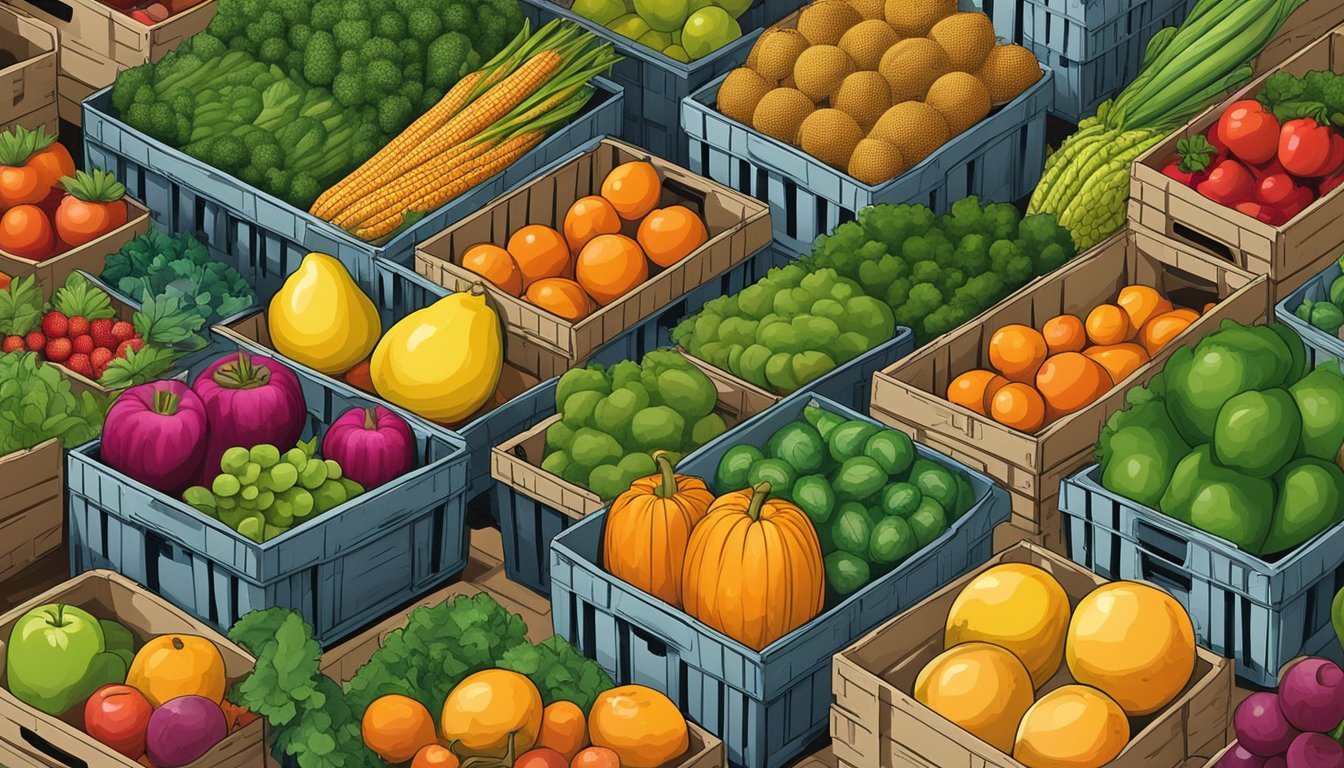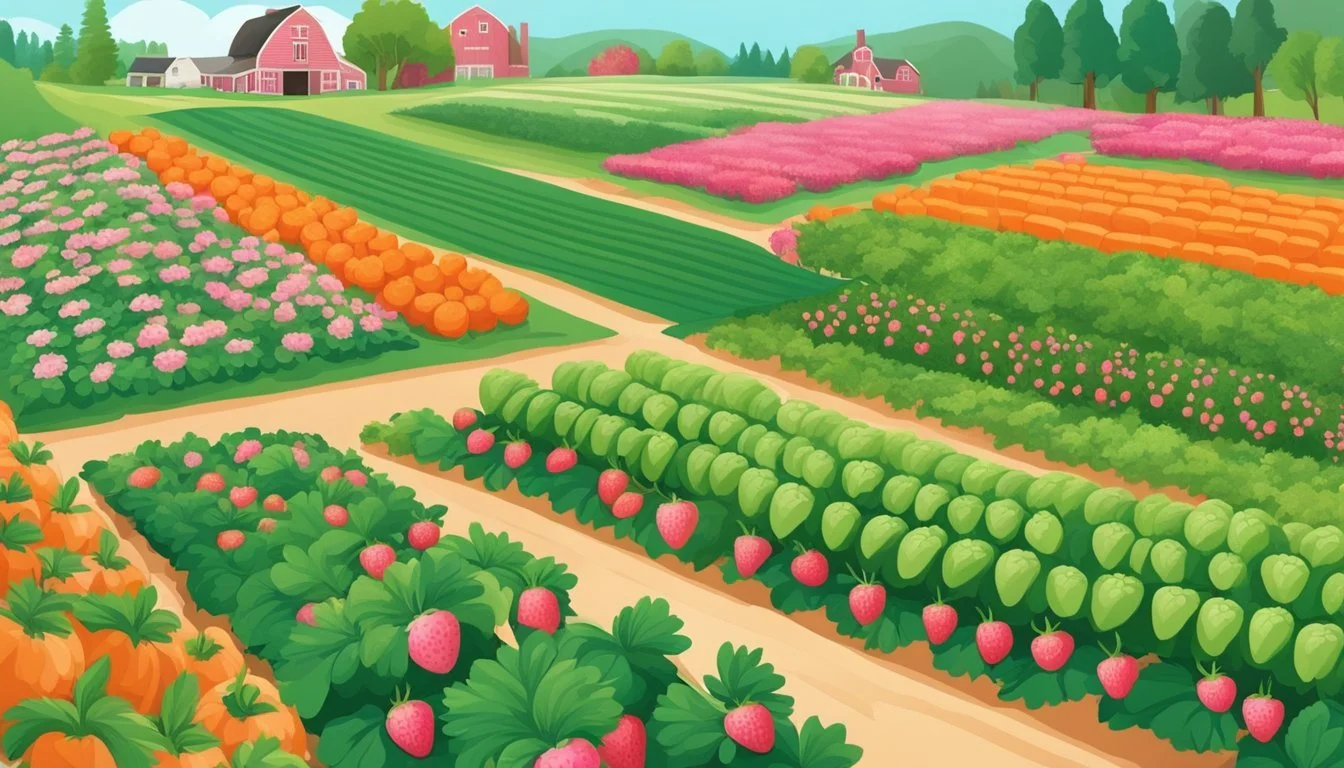Ohio Seasonal Fruit & Vegetables in April
Your Guide to Fresh Produce
This Article is Part of our Ohio Seasonal Fruit & Veg Calendar
April marks a transitional period in Ohio's agricultural calendar where winter slowly gives way to the warmer days of spring. This season ushers in a time of growth and renewal in the state's farming communities. As the frost recedes and the soil thaws, farmers and gardeners across Ohio begin to prepare their fields and plots for planting, and some early varieties of produce become available.
In terms of availability, April is not the peak season for the majority of Ohio's fruit and vegetable crops. However, it does signal the start of the harvest for some early spring produce. Hardy vegetables that can withstand the last of the cold weather, such as spinach and kale, are typically ready to be harvested. Additionally, as greenhouses and other controlled growing environments become more prevalent, certain products such as herbs and lettuces may also be available.
What's in season can vary greatly depending on weather patterns and specific regional climates within Ohio. Despite the limited selection, the produce that is available during this time is particularly prized for its freshness and is eagerly anticipated by local consumers. The anticipation for the full bounty of summer fruits and vegetables begins to build, but until then, Ohioans savor the first tastes of spring's offerings.
Overview of Ohio's Growing Season
April marks a dynamic period in Ohio's agriculture when the state gears up for planting and early harvests. This section provides insight into the specific climate and soil conditions conducive to farming in Ohio, the key crops and their respective harvest periods, the impact of agriculture on the state's economy, and the benefits of consuming seasonal produce.
Climate and Soil Conditions
Ohio's climate in April is characterized by moderate temperatures and increasing daylight, which facilitate the awakening of dormant plants and the preparation of fields for planting. The state's soil types range from well-drained sandy loams to heavier clay loams, both conducive to the diverse agricultural output Ohio is known for.
Key Crops and Harvest Periods
Ohio farmers plant a variety of crops with the progression of warmer spring weather in April. Key crops such as asparagus (What wine goes well with asparagus?) and rhubarb begin their harvest seasons this month, while the groundwork is laid for summer harvested crops like corn and soybeans. (how long do soybeans last?)
Month Crop Start Harvest Start April Asparagus April-May April Rhubarb April-May
State Agricultural Impact
Agriculture is a cornerstone of Ohio's economy, with the state being one of the nation's top producers of soybeans, corn, swine, and dairy products. April's activities set the course for the agricultural year and ultimately contribute significantly to the state's economic health.
Seasonal Eating Benefits
Consumers in Ohio benefit from the flavor and nutritional value of eating fresh, in-season produce. The availability of such produce starts to widen in April, offering a range of fresh flavors and supporting local Ohio farms. Seasonal eating also fosters a sustainable food system by reducing transportation and storage needs.
April Seasonal Produce in Ohio
April in Ohio marks the beginning of the spring harvest, with an array of fresh produce coming into season. Consumers can expect to find the first batches of locally-grown strawberries and the crisp tang of rhubarb. A selection of vegetables, including tender asparagus spears and earthy greens, start to become available as well.
Fruits Available in April
Strawberries: These sweet, red berries start to ripen in April, offering a refreshing burst of flavor.
Rhubarb: Known for its tartness, rhubarb is typically ready for harvest and pairs well with strawberries.
Vegetables Harvested in April
Asparagus: As one of the first spring vegetables, asparagus comes into season in April, prized for its tender stalks.
Onions: Overwintering varieties become available, providing a pungent addition to dishes.
Peas: Both garden and sugar snap peas begin to appear, bringing their delicate sweetness to the table.
Potatoes: Early varieties of potatoes can be found, offering a starchy comfort.
Lettuce and Greens: A variety of lettuces and other leafy greens become ready for harvest, adding crunch to salads and sandwiches.
Herbs and Other Plants
Herbs: Gardeners can start to see herbs such as parsley and chives (how long do chives last?) showing new growth, ready for use in springtime cuisine.
Flowers: Edible flowers, including violets, can start to be foraged or harvested, providing a colorful and delicate garnish.
Preparation and Storage
In Ohio, April marks the beginning of vibrant produce season. Proper storage and preparation are crucial for maintaining flavor and freshness of fruits and vegetables. Utilizing contemporary methods and understanding the requirements of each crop maximizes their shelf life and taste.
Modern Storage Techniques
Modern storage techniques involve controlled environments that maintain the quality of the produce post-harvest. Facilities often use cold storage to extend the life of fruits and vegetables by slowing down ripening and decay processes. For instance, root cellar storage employs cool temperatures and high humidity to keep root vegetables in optimal condition. Techniques such as Controlled Atmosphere Storage (CA) adjust oxygen and carbon dioxide levels to suit specific crops, further enhancing their longevity.
Optimal Storage Conditions for Each Crop
Each fruit and vegetable has unique storage requirements to preserve its quality and flavor:
Apples: Store at 30-32°F with 90% humidity.
Leafy Greens: Keep at 32°F with 95% humidity, wrapped in paper towels to absorb excess moisture.
Root Vegetables (e.g., Carrots, Beets): Best stored at 32-40°F with high humidity in a root cellar.
Table of Optimal Storage Conditions:
Crop Temperature (°F) Humidity (%) Storage Location Apples 30-32 90 Cold storage Leafy Greens 32 95 Refrigerated, dry Root Veggies 32-40 High Root cellar or fridge
Preparation Tips for Peak Flavor
Preparation methods can affect the flavor and nutritional value of the product. For vegetables, blanching and then freezing can preserve flavor and tenderness. Blanching involves briefly boiling vegetables and then plunging them into ice water to halt the cooking process. Fruits are often best consumed fresh but can be sliced and frozen on trays before being transferred to freezer bags to prevent clumping and ease of use in recipes. Storage techniques such as canning and drying also play a role in preserving the fruits and vegetables while retaining their flavor nuances.
This factual synthesis regarding preparing and storing Ohio's seasonal produce ensures that one can enjoy their peak flavor and texture, whether it's enjoyed immediately or saved for later use.
Where to Find Seasonal Produce
In April, Ohio offers an array of seasonal fruits and vegetables available through various sources. Consumers looking to enjoy fresh and local produce have multiple options to explore.
Local Farmers Markets
Farmers markets are a mainstay for fresh, local produce in Ohio. They allow consumers to purchase directly from farmers, ensuring freshness and supporting the local economy. The Ohio Farmers Market Network provides a searchable directory that can assist in locating the nearest market with seasonal offerings in April. Interested individuals can find their closest farmers market with the help of a state-wide map on the network’s website.
Ohio Farm Directories and Maps
Those seeking specific types of produce can utilize Ohio farm directories which list farms by county and the produce they offer. Ohio's Department of Agriculture maintains an interactive map with search capabilities, enabling users to find farms across the state that sell the seasonal produce they desire. This resource helps to connect consumers directly with the source of their food.
Community-Supported Agriculture (CSA) Programs
Community-Supported Agriculture (CSA) programs offer a unique way to buy seasonal products directly from local farms. By subscribing to a CSA, consumers receive a share of the harvest throughout the season. This fosters a direct link between Ohio farms and local communities, ensuring availability of fresh produce. A list of active CSA programs can be found on agricultural websites pertinent to Ohio.
Retail Options for Seasonal Eating
For those who prefer the convenience of retail shopping, many Ohio grocery stores and specialty food shops highlight seasonal and locally-sourced produce. They often establish partnerships with local farms to provide fresh regional produce. Ohio consumers may inquire within their favorite retail locations to discover which products are sourced from in-state farms and are in season for April.
Looking Ahead: Upcoming Seasons in Ohio
As Ohio transitions from spring to summer, a variety of fruits and vegetables become ripe for harvesting. Each upcoming season ushers in a new wave of produce.
What's Next in May
In May, Ohioans anticipate the arrival of strawberry season, which signals the beginning of the region's rich fruit harvest. Gardens and markets will soon feature peas and leafy greens, with radishes and spring onions adding crunch to salads.
Summer Bounty Starting in June
June marks the start of summer with an explosion of flavors. Peaches and watermelon become garden staples, epitomizing the taste of sunshine. Vegetables like cauliflower and various peppers also ripen, offering a colorful palette for seasonal dishes.
Fruits
Peaches
Watermelon
Vegetables
Cauliflower
Peppers
Fall Harvest Beginnings in September
When September arrives, fall is in the air and the harvest shifts. Corn reaches its peak, and fields of leeks and turnips prepare for the cooler months. These crops herald the start of the heartier harvest season.
Corn
Leeks
Turnips
Planning for Winter Availability
By November, preparing for winter is key. Ohio farms focus on staples that store well through the cold months. Hearty greens, potatoes, carrots, and garlic become invaluable for nutritious and warming meals.
Greens
Potatoes
Carrots
Garlic
Gardening Tips for Ohioans
In Ohio, April marks a pivotal time for gardeners to begin preparations for a fruitful growing season. Coordination with the state's climate and understanding of crop rotation principles are essential for a successful harvest.
Starting Your Own Backyard Garden
Ohioans looking to start their own backyard garden should focus on selecting cold-hardy vegetables that can withstand the unpredictable temperatures of early spring. Lettuce, including varieties like Butterhead, Boston, and Loose Leaf, can tolerate frost and are ideal to plant during this time.
Key Early Spring Crops: Lettuce, Spinach, Peas
Frost Tolerance: Crucial for early crops
Planting Tip: Protect early plantings with garden fabric or mulch
Understanding Seasonal Crop Rotation
Seasonal crop rotation is a critical strategy for Ohio's gardeners to manage soil health and mitigate pest populations. For a balanced garden ecosystem, one should rotate crops from the following categories annually:
Crop Category Examples Leafy Greens Lettuce, Spinach Nightshades Tomatoes, Peppers Legumes Peas, Beans Root Vegetables Carrots, Potatoes
Implementing crop rotation not only contributes to a diverse harvest but also enriches the soil with varying plant nutrients.
Growing Conditions and Soil Management
The growing conditions in Ohio necessitate an active approach to soil management. During April, as the ground thaws and temperatures rise gradually, farmers should:
Test Soil: Check for pH levels and nutrient composition.
Amend Soil: Apply compost or organic matter to enhance fertility.
Prepare Beds: Till soil to aerate and prepare for seeding.
Water management is equally important, ensuring moisture is consistent but not excessive, to avoid seed rot or disease.







